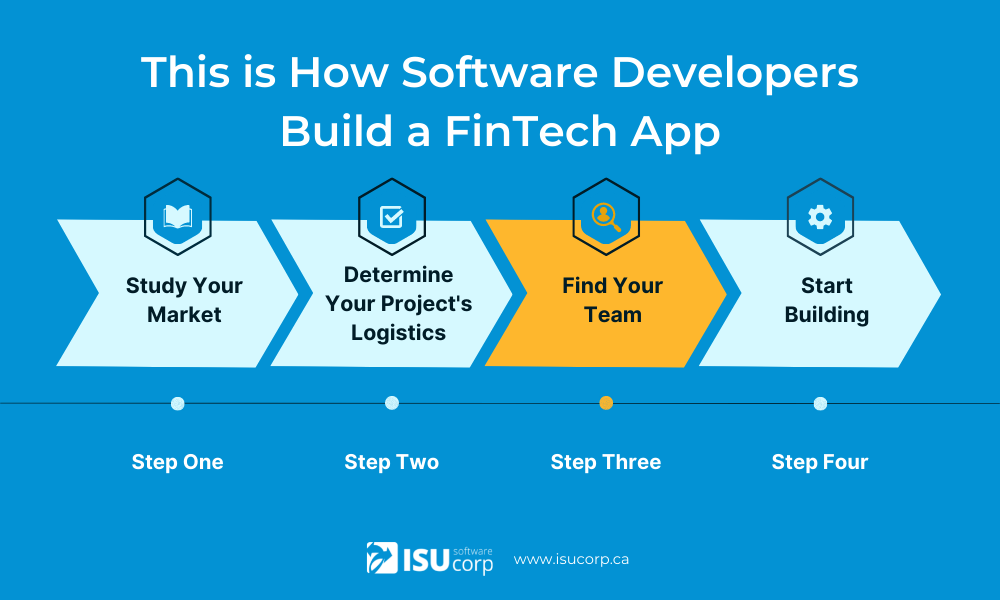Between 2020 and 2030, the global FinTech market value is expected to grow sixfold from $110 billion to nearly $700 billion. In this section, we’re shifting the focus from the services offered to the technology that provides an application to deliver them. We’ll start with the basic understanding that putting together a FinTech app is not an overnight process. Many components go into its construction to ensure both the quality and security of back-end data processing and front-end user experience.
The IT technologies used in the development of FinTech services are what have pushed the industry to succeed. When consumers experience the convenience aspect of FinTech, the front-end functions are a mere puppet. The digital mechanics behind those functions pull the strings and interconnect to provide that convenience. These mechanics and their intended results are what we’re going to cover in the following sections.
Artificial Intelligence (AI) and Machine Learning (ML)
AI and ML are two technologies that are dominantly used in the development of FinTech applications. The main reason is because of their ability to assist with processing large quantities of data. This data is collected from both consumers and global trends which, when processed, determine the service that is delivered. Here are some of the results from these processes:
Security and Identifying fraud: FinTech platforms work while processing a very high volume of data 24/7. This raises the risk of criminal activity which could easily slip by traditional processing methods that lack the resources of AI and ML. With these modern advancements, they can trace and detect patterns in the data, allowing them to flag a cyber-criminal when irregular data is recognized. Research has shown that this technology can reduce fraud by 70% with a 90% accuracy rate in detection.
Options: Users of FinTech apps have access to insights that will give them the advice to manage their finances. This is broken down into easy-to-understand visuals such as pie charts, monthly spending tracked on a progress bar, and organizing payments to be made. Users will then get insights based on this data for how to put themselves in a more beneficial financial position.
Managing Assets: As stated previously, AI and ML stay in tune with global financial trends which they use to make predictions for investment opportunities. Users have access to this info and can choose to make investment decisions based on the advice provided.
Personalizing Customer Support: AI and ML data tracking collects user information which benefits the platform in tending to the needs of consumers. This ties back into the technology that keeps up with user habits. Ultimately, it makes customer support much easier and keeps access consistent through automated bots.
Microservices
In software development, microservice architectures are a trend that developers have recently been utilizing in their work. Microservices are large-scale applications that are condensed into smaller autonomous blocks. This makes it simple for developers to work on areas of the system without disrupting the entire application. When it comes to interfaces and operations in FinTech, it is necessary to ensure users have access to the latest and greatest.
Here are some specific areas of coverage:
Agility within the application: You can add or remove as well as innovate any solution to keep up with changes in the market.
Highly reliable: When several components are operating autonomously within an application, it reduces the risk of system failure. When one component goes down, everything else continues running and the owner is notified that it needs to be fixed.
Transferable between systems: Once a microservice is developed, the components of the application it was developed for are reusable for various FinTech solutions. This is because a microservice architecture can connect to other systems through API. The API will act as the intermediary that allows the applications to communicate.
Increased development speed: A software developer would not have to start from scratch when building a microservice. Going back to transferability, there are unique aspects of microservices that may not be used much but can be added to developing solutions. Developers can create a minimum viable product (MVP) with these microservices and adjust the system based on how users react to it.
Blockchain
The central spot for storing data for FinTech is in the Blockchain. This technology has risen to popularity in recent years for its ability to send secure transactions and utilize cryptocurrency instead of fiat money (money made legal tender by the government). The decentralized and encrypted structure of the Blockchain makes the management of transactions safe and highly efficient. When AI meets the Blockchain in an application, it allows the processing and supervision of data to operate easier and smoother in addition to avoiding potential mistakes. Companies have turned to this pairing for these specific reasons among others, and FinTech is no exception to the shift.
Here are some ways FinTech uses Blockchain to its advantage:
Easily pay peer-to-peer (P2P): This can be compared to Whatsapp’s encrypted messaging system that allows users to send messages around the world instantaneously. Blockchain processes payments similarly, eliminating the need for any middleman services in the process.
Digital ID: To eliminate fraud in the Blockchain network, every user needs to validate their identity, like most other platforms. As soon as they’re registered in the system, tracking their activity is very simple and tracked regularly.
Cryptocurrency Exchange: Applications like Coinbase or Crypto.com use Blockchain to allow users to trade cryptocurrency assets.
Critical Components of a FinTech App
Every FinTech app is going to serve a different purpose. You can be a digital payment service, online banking, InsurTech, online lending, or even a crypto wallet or platform. Whichever service you’re fulfilling, you need to assess what aspects are critical for your application. To get you started, here are some sought-after features often used in FinTech apps:
Visual data display: Breaking down information regarding income, expenses, and transactions.
Flexible UI: Your application should be easy to navigate and understand, as well as have a way to engage users. For example, the crypto exchange application Coinbase uses a “learn and earn” feature where users are taught and quizzed on crypto assets in exchange for virtual currency.
Gateway for payments: This basic feature allows users to make money transfers and payments. This is commonly the main selling point to get users to download a FinTech app.
Virtual assistance: Users are increasingly interacting with virtual assistance (especially those that use a voice) for the unique experience it offers. Additionally, applications need a front-facing support system to help customers.
Security: FinTech as an ecosystem is locked down and secure, yet one of the areas still in need of innovation is the security of FinTech apps. Additionally, studies have found that hackers attempt to break into computers connected to the internet every 39 seconds.
So now that we’ve covered the details of what your FinTech app should consider in its development, what's left is how to do it. We’re going to break this down into a three-step process:
Step One: Study your market
Determine whether or not there is a need for your service. To do this, you’ll start by finding services similar to yours and evaluate how well they’re doing. What could you do better? Also, how are users interacting with these services? You want to determine if there are limits on the existing services and/or if your vision is something people need.
Step Two: Determine your project's logistics
Once you’ve analyzed the market you want to enter, you will have an understanding of who will use your application and what components you will need to generate appeal. This will then lead to evaluating the timeline and budget needed. Of course, both timeline and budget will vary depending on the technology stack you go with which will be determined after speaking with your software developers.
Step Three: Build your team
A FinTech application is highly complex and will require a team of experienced developers with the tools for the task. Typically, outsourcing this kind of development is a company's best bet when they don’t have an in-house team. Additionally, outsourcing would help save on your budget as you’re only paying for the results that the software development team produces. It’s ultimately going to come down to finding a team you’re comfortable with and that understands your vision and who can then make that vision reality.
Finally
When putting together a FinTech application, the process is going to be subjective based on your business's goals. It’s going to be a bit of trial and error especially if you take it on in-house, but that will provide answers as you go. The great thing about developing a FinTech app is that there is so much variety in terms of how you offer your service and how you innovate it. With the right software, your application can scale and fulfill the needs of millions of users.
Written By Ben Brown
—
ISU Corp is an award winning software development company, with over 17 years of experience in multiple industries, providing cost effective custom software development, technology management, and IT outsourcing.
Our unique owners mindset reduces development costs and fast-tracks timelines. We help craft the specifications of your project based on your company's needs, to produce the best ROI. Find out why startups, all the way to fortune 500 companies like General Electric, Heinz, and many others have trusted us with their projects. Contact us here.






